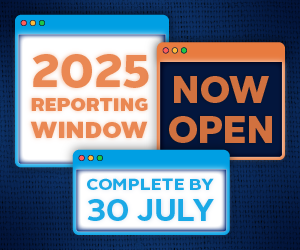By Ed Baker (@ejb_baker), Senior Specialist, Climate and Energy Transition and Thalia Vounaki, Head of Data Analytics and Insights, both the PRI
Seventeen months ago, the PRI announced that reporting against the Taskforce on Climate-related Financial Disclosures (TCFD) based governance and strategy indicators would become mandatory from 2020 for investor signatories to report on, but still voluntary to disclose. The analysis of this year’s reporting cycle, together with 410 individual investor climate reports, has now been published in the PRI 2020 climate snapshot, a dynamic online report which provides aggregate analysis of climate reporting by investor type, country, assets under management and asset class. The top four takeaways from 2020 climate report are:
1: A 3.5x increase in TCFD-based investor reporting to the PRI in the first quarter of this year
The increase in the volume of responses is in-line with the mandatory requirement for investor signatories to report. 2,097 investors (443 asset owners, 1654 asset managers) representing $97 trillion in assets report this year as opposed to 591 investors last year.
These 2,097 investors represent 75% of PRI’s investor signatory base. The remaining 700 are signatories who joined the PRI recently and did not have to report during their reporting grace period as of this year. Using 2018 OECD data, PRI estimated our signatory base at the end of March 2019 to represent approximately 24% of all asset owners and 74% of all investment managers globally by AUM, which can be seen as a ballpark figure of those who have responded this year.
2: The US was the largest market reporting
Highlighting that climate reporting is not just a UK and Europe story, by country the US was the largest market with 382 investors reporting. Canada and Australia are in the top five and Japan is also notable with 65 investors reporting.
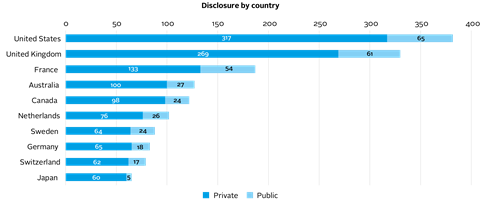
3: 79% of asset owners have reported board oversight of climate change
In some markets the percentage was as high as 100% (e.g. France, UK). Unsurprisingly, the alignment against the more quantified recommendations (metrics, targets in particular) lags.
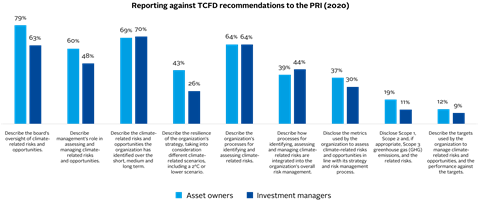
Yet, the alignment of responses with the TCFD recommendations has increased across the board on previous years.
More than 50% of investors providing details on how their board execute their climate oversight had chosen not to report on this question in 2019. Some are signatories that made changes to their practices ahead of the 2020 mandatory reporting. However, it is likely that some already had a board with climate oversight, hence mandatory reporting ensured they do not miss out communicating material information to their clients and beneficiaries.
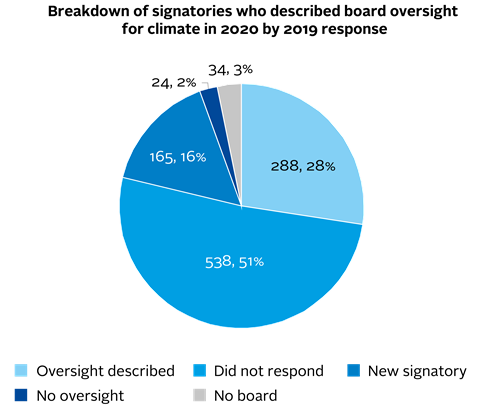
4: An increase in self-reported data does not necessarily signify an increase in underlying investment practice
Only 20% of investors opted to make their responses public, and even fewer have - by our analysis- fully implemented the Taskforce’s recommendations. A staircase analysis of the quality of investor reporting shows that less than 8% of the reporting signatories are in the top two categories. Thus, for most investors TCFD implementation remains at an initial stage.
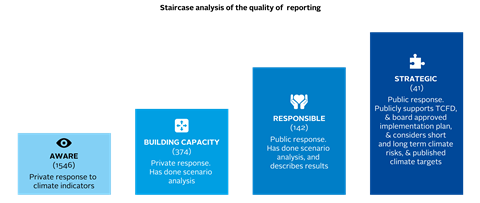
In summary, making reporting mandatory for investor signatories has led to a substantial difference in the volume of investor TCFD-based reporting. It has likely driven investors to take steps towards implementing TCFD recommendations, starting with board/management oversight and strategic analysis. Yet, this isn’t sufficient in itself to lead to full implementation of the recommendations. Further work is needed to advance the maturity of the climate reporting framework and reduce information barriers to adoption. Through the publication of practical guidance, investor collaborations and participation in regulator taskforces as well as the reporting framework, PRI will continue to support signatories on this journey.
This blog is written by PRI staff members and guest contributors. Our goal is to contribute to the broader debate around topical issues and to help showcase some of our research and other work that we undertake in support of our signatories.
Please note that although you can expect to find some posts here that broadly accord with the PRI’s official views, the blog authors write in their individual capacity and there is no “house view”. Nor do the views and opinions expressed on this blog constitute financial or other professional advice.
If you have any questions, please contact us at [email protected].



